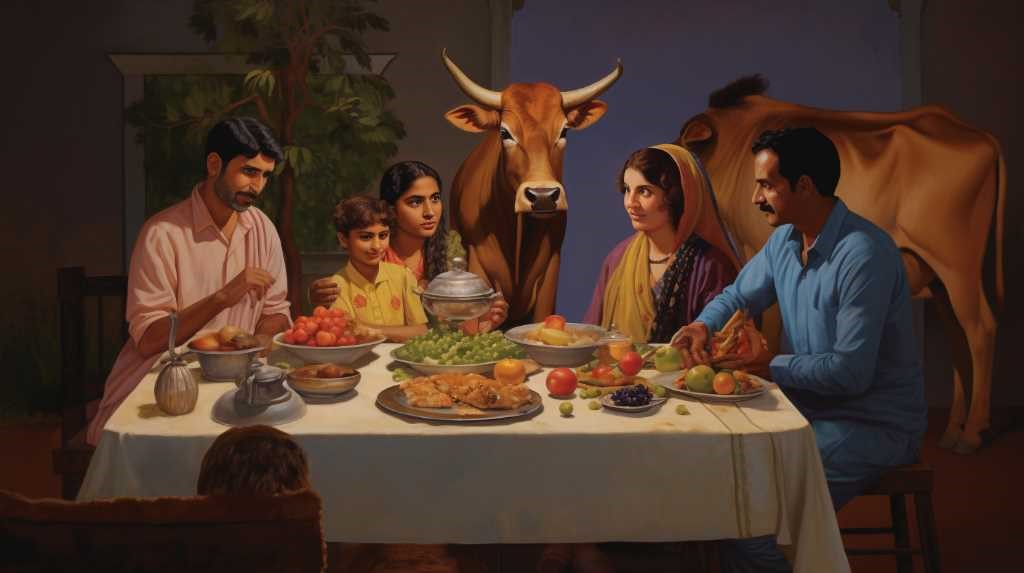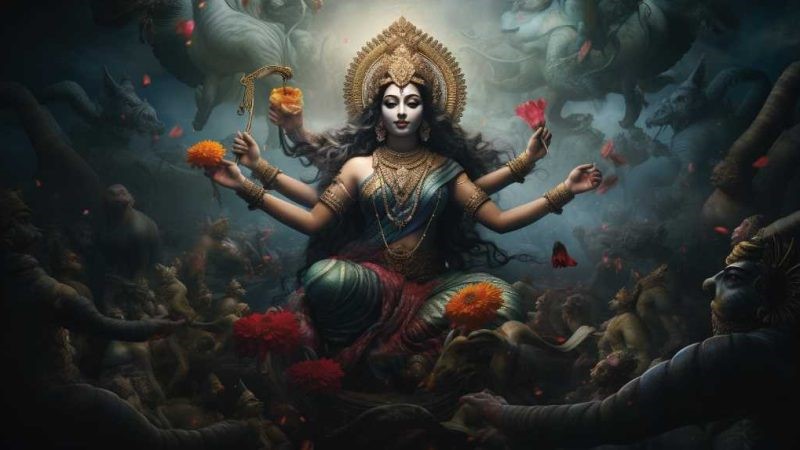Dietary Do’s and Don’ts Forbidden Foods in Hinduism

Hindu traditions place a lot of importance on what people eat. This is because they believe eating certain foods can affect not only their health but also their thoughts and actions. Many Hindus choose not to eat meat. They do this to follow the idea of ‘Ahimsa,’ which means not harming any living thing. This idea is why many Hindus are vegetarians or eat mostly plants.
When it comes to the types of foods Hindus eat, they have three groups: Sattvic, Rajasic, and Tamasic. Sattvic foods, such as fresh fruits and vegetables, are thought to be the purest. They’re supposed to help keep your mind calm and clear. On the other hand, Hindus usually don’t eat Rajasic and Tamasic foods because these can have a negative effect on the mind and body. These include some meats, onions, garlic, and things like alcohol.
Fasting, or not eating food for a certain period, is also a big part of Hinduism. People fast for different reasons. Some do it to clean their body and spirit, while others do it to show their commitment to their faith.
Understanding Hindu food rules means looking at the culture and religion behind them. It’s not just about following a list of do’s and don’ts. It’s about why these rules exist and how they help people live a certain way. For example, choosing to eat Sattvic foods can lead to better health and a more peaceful mind, which is something many people might find beneficial.
Understanding Ahimsa: Non-violence
Ahimsa means not hurting any living things, and it’s a big deal in what Hindus eat. They don’t eat meat, fish, or often eggs because they don’t want to harm animals. This choice is about kindness and being aware of how actions affect others.
Being kind also means picking food that’s gotten in a way that doesn’t hurt nature. It’s about living well with the world around us. For example, instead of buying any vegetables, a person might choose ones grown locally without harming the environment.
This way of living isn’t just about food, though. It’s about being caring in everything you do.
The Significance of Sattvic Foods
In Hindu eating habits, Sattvic foods are really important. These foods are clean and healthy, and they help your body and your spirit. Ayurveda is a system that guides what Hindus eat. It breaks down foods into three groups. Sattvic foods are in the first group, and they’re all about being pure. The other two types are Rajas, which means they cause action, and Tamas, which means they make you slow or lazy.
Why are Sattvic foods so good for you? Well, they help you think clearly, feel peaceful, and stay balanced. If you want to live a calm life and grow spiritually, these are the foods to eat. Most of them come straight from plants, like fruits, veggies, grains, beans, nuts, and seeds. There are also dairy products, but only if they come from animals that haven’t been hurt.
When you eat Sattvic foods, it’s easier to meditate and get in touch with your higher self. If you’re looking to try some Sattvic foods, start with basics like fresh fruits such as apples and bananas, whole grains like brown rice or quinoa, and nuts like almonds or walnuts. You could also enjoy dairy products like milk or yogurt, but make sure they’re from sources that treat animals kindly. These foods not only fuel your body but also help your mind stay focused and calm.
Avoiding Tamasic and Rajasic Items
Hindus often choose Sattvic foods because they’re good for both the body and mind. However, they tend to stay away from Tamasic and Rajasic foods. Why? Because these foods can affect your health and how you feel inside.
For example, Tamasic foods like meat, fish, onions, and garlic can make you feel tired and not very sharp. They can also get in the way of your spiritual progress.
Rajasic foods, on the other hand, such as spicy meals, coffee, and chocolate, can make you feel too excited and make it hard to stay calm and focused.
By not eating these things, people are not just picking what to eat; they’re choosing a way of life that helps them stay disciplined and keep their mind on their spiritual goals.
In a nutshell, if you’re trying to live a healthier, more balanced life, try to eat less of the stuff that makes you sluggish or too hyper. Instead, go for foods that keep you feeling clear-headed and calm, like fresh fruits and vegetables, grains, and nuts.
It’s not just about the food—it’s about how you want to live and feel every day.
Restrictions on Meat and Fish
Hindu rules about eating often say no to eating meat and fish. This is because Hindus believe in not hurting living things and want to keep their minds and bodies clean. They think eating meat is wrong because it means killing an animal. Fish are sometimes not seen the same as other animals, but many Hindus still don’t eat them to avoid harm.
For example, the Hindu text called Manusmriti tells people not to eat meat because it can lead to bad karma, which affects a person’s spiritual growth. So, the food rules in Hinduism are about being healthy and doing the right thing for your soul.
Hindus who choose to be vegetarians do so to live by these values. They eat foods like lentils, fruits, and vegetables instead of meat and fish. This way, they show respect for life and keep their bodies and minds in good shape.
Observing Fasting Rituals
In Hinduism, fasting is a key part of how people eat and live. It’s not just about not eating – it’s a way to clean your mind and body to help you focus more on your spiritual life. This kind of fasting can be different for everyone. Sometimes people might skip certain foods, and other times they might not eat or drink anything at all. This usually happens during special times of the month or during big religious events like Navaratri and Shivaratri.
When someone decides to fast, they think about their own health and what they can handle. It’s a very personal choice. Fasting can mean you’re saying sorry for something, showing you’re thankful, or giving something up. It’s a way to remember that even though food keeps our body going, our spirit needs different kinds of care to stay strong and healthy.
Conclusion
Hinduism’s diet guidelines are closely linked to its core beliefs about non-harm, purity, and the mind’s influence on the body. Eating Sattvic foods, which are fresh and healthy, helps people stay peaceful and pure. On the other hand, Hindus avoid Tamasic and Rajasic foods, which are believed to make the mind dull or overly active, as this can get in the way of meditation and spiritual growth. Not eating meat or fish and fasting at certain times are ways Hindus show respect for life and keep their minds and bodies clean. These practices aren’t just rules to follow; they help Hindus live out their values and grow spiritually.
Hindus believe that all living creatures have a soul, and so many choose not to eat meat. This is an example of Ahimsa, or non-violence. To give a specific recommendation, Hindus often include a variety of fruits, vegetables, nuts, and grains in their diets, which are considered Sattvic. These foods are not only healthy for the body but also promote a calm and clear state of mind, which is important for spiritual practices like meditation.
In a nutshell, when Hindus pick foods that are good for both their bodies and their spiritual well-being, they are putting their beliefs into practice. By doing this, they aim to live harmoniously with the world around them.






